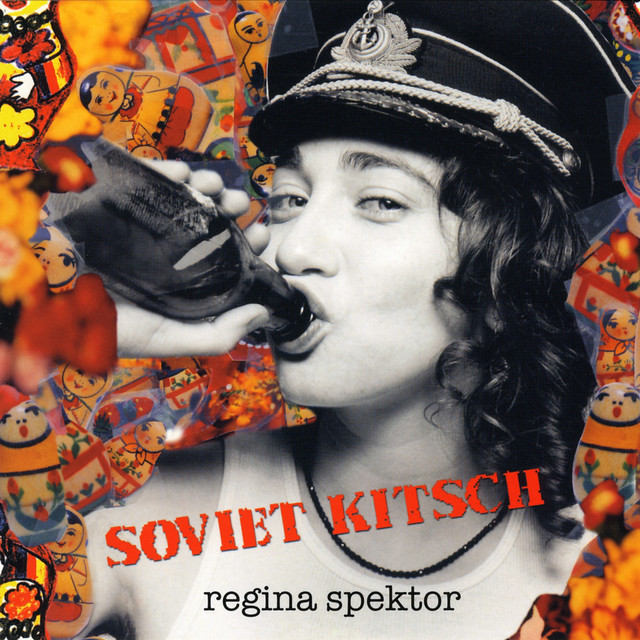
I had never heard of Regina Spektor until my daughter asked me for a lift downtown to a concert on Queen’s Quay. I asked who Regina Spektor is and my daughter loaned me a CD called Soviet Kitsch (which has been ranked by New Musical Express as #84 on its list of the top 100 albums of the last decade). It was one of those odd occasions when I encountered something in pop culture without realizing it was a literary reference. Then I read Milan Kundera‘s The Unbearable Lightness of Being and it leapt off the page at me. Of course, as with just about everything else nowadays, I could have made the association if, instead of reading the novel, I had searched “Soviet Kitsch” on Wikipedia.
According to the author of the wikipedia entry, Kundera uses “Soviet kitsch” as an expression of “the vacuous aesthetics of communism.” Well … maybe, but there’s more to it than that. Here’s the passage from the novel where the phrase occurs. Note, that my translation uses the phrase “Communist kitsch” but that’s probably neither here nor there:
Sabina’s initial inner revolt against Communism was aesthetic rather than ethical in character. What repelled her was not nearly so much the ugliness of the Communist world (ruined castles transformed into cow sheds) as the mask of beauty it tried to wear – in other words, communist kitsch.

However, the preceding chapter makes it clear that Kundera’s concern for kitsch is more general than the aesthetic of a single political ideology. The concern for kitsch has its roots in the book of Genesis and infects all three major western religious traditions and their related political ideologies. Kitsch denies the acceptability of shit or, in its more extreme form, denies the very existence of shit. (For reference purposes, I’ve reproduced the entire passage at the end of this post.)
Quite apart from the simple “vacuous aesthetics of communism,” Kundera’s passage implies other aesthetic considerations:
• although beauty, alongside goodness and truth, is typically understood as a transcendental value, traditional western religious thought is incompatible—even hostile—to the beautiful;
• ironically, religion undermines beauty with another transcendental, goodness, or at least a distortion of goodness which it calls morality;
• communism is a species of religion in the Hebraic tradition, just like Christianity;
• beauty implies shit and may not be able to exist without shit.
I think it’s also fair to suppose that while the presence of shit may be necessary in a work of art, it does not follow that, because a work includes or implies shit, it must therefore be a work of art. Such a work might be nothing more than an uninspired portrayal of shit.
Let’s test Kundera’s observations with some examples
1. My Sweet Lord. I find Kundera’s definition of kitsch helpful in understanding the holy row that erupted between the Catholic League and sculptor Cosimo Cavallero when the latter unveiled his chocolate Jesus titled “My Sweet Lord” in March, 2007. The Catholic League took exception to Christ’s nudity. It was unacceptable that their Lord and Saviour, the divine Son of God who assumed human form, should nevertheless assume every part of the human form, including the penis and testicles. In Kundera’s terms, the Catholic League would prefer a religious aesthetic of kitsch. I wonder if the Catholic League’s sensibilities were further aggravated by the fact that chocolate is the same colour as shit. (As an aside, Tom Waits’ song, “Chocolate Jesus” provides a fun antidote to kitschy religious philistines.)
2. Kawaii (Japanese Cute Culture). I’ve never understood the appeal of kawaii. In terms of audience, execution, and sensibility it is thoroughly adolescent. As Eleanor Heartney observes: “kawaii seems to serve as a shield against maturity, adult responsibility and sexual desire.” Its rise to popularity occurred at a time when Japan was reeling from Hiroshima and the dismantling of its military machinery. Unsure how to define itself, some like Yukio Mishima exhorted the Japanese people to return to their traditional values—and committed seppuku to make absolutely certain everyone understood what he meant. Mishima was an artist and three-time Nobel prize nominee who didn’t flinch at the sight of shit and, among other things, produced some of the finest examinations of male (homo)sexuality ever written in any culture (see e.g. Confessions of a Mask). Japanese culture, however, ignored his call and ran in the other direction, preferring to avoid serious self-examination. The secular religion of Japan is now overrun by kitsch.
3. Disney. If kawaii is the heartbeat of Japanese kitsch, then Disney is America’s myocardial infarction. While the rise of kawaii can be traced to a single event, the rise of Disney is a more diffuse account with no single cause. I have my own theory. Disney kitsch is the American dream with half the story left out. Like Kundera’s communism, Disney’s American dream is a religious expression which denies the existence of shit. The denial—the big lie—is that the riches of the American dream are possible without the exploitation of other people and the environment. So, for example, Disney tells Pocahontas (1995) as a love story. Children never learn that Pocahontas was ten when she met John Smith, that they never married, that she married somebody named John Rolfe, that the Jamestown colony probably infected the Powhatan’s with smallpox, that this was the beginning of successive waves of displacement which would drive native Americans to the Pacific and almost complete their extermination three centuries later. The same colonialism-as-kitsch gets played out in The Emperor’s New Groove (2000) and Junglebook (1967).
As a final note, Kundera’s discussion of kitsch poses an interesting problem for artists (like Cosimo Cavallero) who want to engage in serious conversation about issues of kitsch, banality, consumer culture, etc. without succumbing to its art-destroying tendencies. What would a serious treatment of kitsch look like if it were to portray kitschyness in good faith while retaining its aesthetic integrity? Is this even possible? What is Regina Spektor’s album? What is The Unbearable Lightness of Being for that matter?
Kundera on kitsch:
Behind all the European faiths, religious and political, we find the first chapter of Genesis, which tells us that the world was created properly, that human existence is good, and that we are therefore entitled to multiply. Let us call this basic faith a categorical agreement with being.
The fact that until recently the word “shit” appeared in print as s— has nothing to do with moral considerations. You can’t claim that shit is immoral, after all! The objection to shit is a metaphysical one. The daily defecation session is daily proof of the unacceptability of Creation. Either/or: either shit is acceptable (in which case don’t lock yourself in the bathroom!) or we are created in an unacceptable manner.
It follows, then, that the aesthetic ideal of the categorical agreement with being is a world in which shit is denied and everyone acts as though it did not exist. This aesthetic ideal is called kitsch.
“Kitsch” is a German word born in the middle of the sentimental nineteenth century, and from German it entered all Western languages. Repeated use, however, has obliterated its original metaphysical meaning: kitsch is the absolute denial of shit, in both the literal and the figurative sense of the word; kitsch excludes everything from its purview which is essentially unacceptable in human existence.